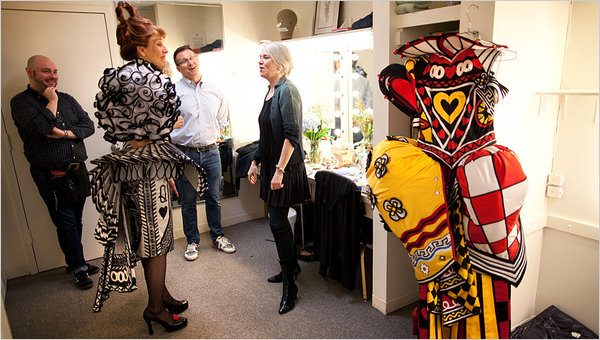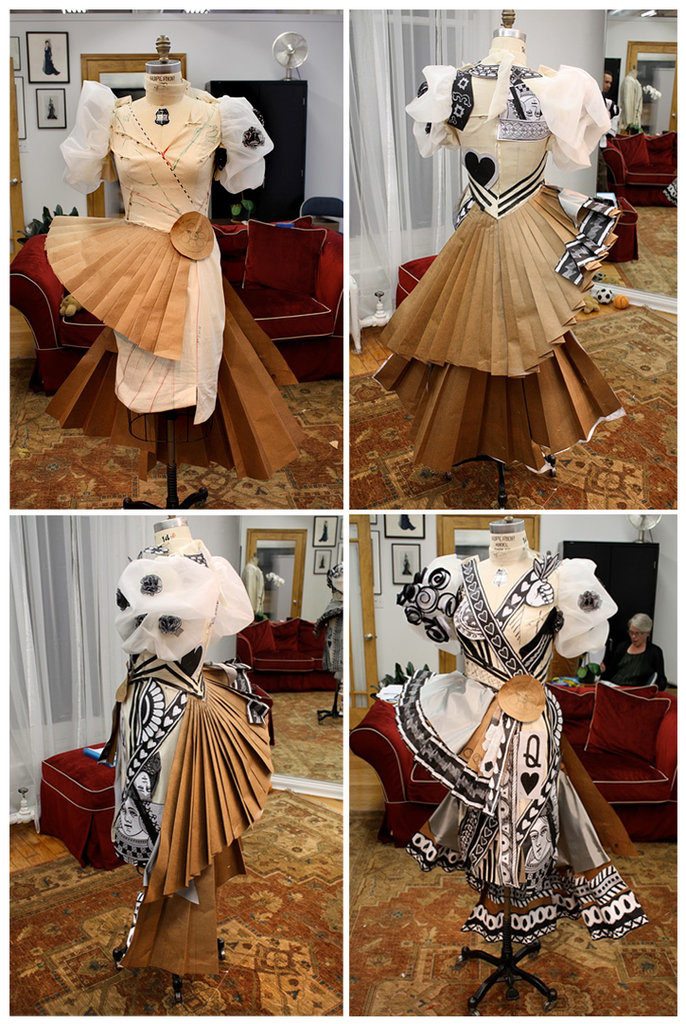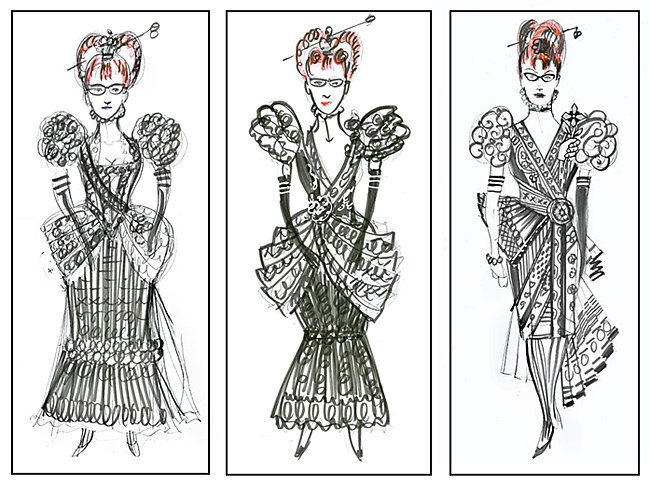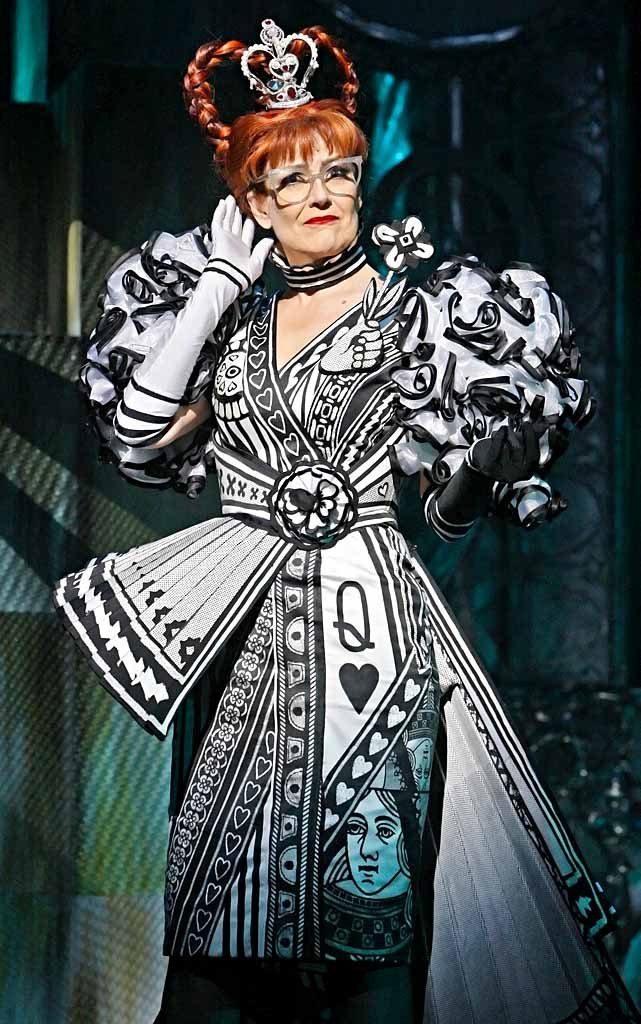New York Times
What Befits a Legendary Queen
by Sylviane Gold on April 3, 2011
Susan Hilferty Creates Queen of Hearts for ‘Wonderland’

Karen Mason, who plays the Queen of Hearts in “Wonderland” on Broadway, during a costume fitting with the designer Susan Hilferty, the costume maker Eric Winterling, center, and a dresser, Jay Woods; her Act II dress is at right. ROBERT CAPLIN FOR THE NEW YORK TIMES
THE first time Karen Mason saw the elaborate, multilayered black-and-white dress that Susan Hilferty designed for her character, the Queen of Hearts, in the musical “Wonderland,” she burst into tears.
“It was just beyond anything I had ever expected,” she said. “Every detail on it took my breath away.”
Ms. Hilferty, who won a Tony for her “Wicked” costumes, had seen such emotional responses before.
“A costume designer works with actors on a very, very intimate level,” she said. “My real work is watching them see themselves in a mirror.”
“Wonderland,” which opens at the Marquis Theater on April 17, is an updated take on Lewis Carroll’s Alice stories, with songs by Frank Wildhorn and Jack Murphy (Tony nominees for “The Civil War”). In it, a newly separated mother who has just moved to Queens, played by Janet Dacal, finds herself descending into Wonderland after pushing a button on her elevator.
Ms. Hilferty, who often refers to herself as a storyteller whose medium happens to be clothes, decided her Wonderland would be simple. The initial palette would be derived from the original black-and-white drawings of John Tenniel before bursting into intense color in Act II. The White Rabbit would manage without bunny ears, and the other animals would be equally low key.
“But,” Ms. Hilferty said, “I don’t know what it is about the Queen of Hearts. She needed to be taken to another place.”

From Two Dimensions to Three; Playing with Paper; Thinking About the Wearer; The Home Stretch. MARINA RETI
Over the course of several conversations in recent weeks Ms. Hilferty, a youthful 58, recounted the journey that took the Queen of Hearts from the sketchpads of Ms. Hilferty’s Chelsea studio to Eric Winterling’s costume shop and, finally, to the wardrobe room of the Marquis Theater. Below, she recalls some of the steps of her trip.
Sketching Out Ideas
“In a show like this, where I’m making up a world, I don’t know where to begin,” Ms. Hilferty said. “So I just start with ideas.”
She looked at playing cards. She considered queenly things: crowns, sashes, gowns. She studied the illustrations in Carroll’s original, handwritten manuscript.
“I was wrestling with many things,” she said. “I loved the roughness of his hand, but I also really liked the graphicness and the abstractness of the cards. And I knew that I was telling the story from a contemporary point of view.”
Ms. Hilferty made dozens of sketches. In the farthest two at the left she turned the Queen into a stack of heart shapes, using braids, exaggerated sleeves and side bustles. The eyeglasses were meant as a contemporary touch, but the look still struck her as too period and too formal.
“And it didn’t have enough card-ness,” she said.
A Blueprint
“When you think of Queen Elizabeth or Lady Di, you think of them in contemporary clothes,” Ms. Hilferty said.
So she switched to a short skirt. She liked the peplum overskirt in the long gowns she’d drawn, but the symmetry felt wrong.
“So I started to skew it a little bit,” she said. “With her peplum on the side, I was feeling like there’s a deck of cards there. And I actually started copying various graphics from the playing card. There were all sorts of different patterns that I loved.”

"In a show like this where I'm making up a world, I don't know where to begin," Ms. Hilferty said. "So I just start with ideas." ILLUSTRATIONS BY SUSAN HILFERTY
She noticed that in the card there’s always a disembodied hand holding a flower. She tacked the flower — and the hand too — onto the dress, like a corsage.
By the time she made the sketch on the far right above, Ms. Hilferty said, “I knew I had her.”
From Two Dimensions to Three
Ms. Hilferty called the initial muslin mock-up, above, “a road map.” Fitted to Ms. Mason’s body, it provided the framework for turning a two-dimensional sketch into a wearable garment.
At this stage there were many open questions, Ms. Hilferty said: “What is it? How does it work? How does the front meet the back? How does Karen get into it?”
Muslin is easy to write on, and it’s a good thing.
“We’re trying to figure out scale,” Ms. Hilferty said. “We’re solving very specific problems, like how can she walk in it? How is it going to sit?”
Answering the last question wasn’t hard.
“I knew there were no chairs on the set,” she said with a smile. “So I was pretty sure sitting was not going to come into it.”
Playing With Paper
Ms. Hilferty knew which of the queen of hearts’ graphic elements she wanted to use: the ruff, the Q, the heart, the face. But she didn’t know how she would use them or what size they needed to be.
She sorted it out by photocopying the playing card and blowing up the patterns. Then she made cutouts and pinned them to the muslin, enlarging, reducing, arranging, rearranging, “trying to get the right proportions.” The pleated train is her reference to a fanned-out deck of cards.

Karen Mason onstage in her full regalia. MICHAL DANIEL
In the photograph above, the pieces are just beginning to fall into place. “I’m literally sketching in three dimensions, Ms. Hilferty said.
Thinking About the Wearer
“So much of our job is working with a performer,” Ms. Hilferty said. “I love when you’re actually changing a performer’s physicality. But if you put someone in a train or four-inch heels, they have to figure out a whole new language. So we figure it out together.”
For example the pleated back panel was attached at the waist, above. But Ms. Mason found it uncomfortable. Ms. Hilferty dropped it down a little.
Then it got in the way of Ms. Mason’s climbing the stairs she must navigate onstage. The fantail was adjusted yet again.
Most costumes can be completed with three fittings. This one required several more. But every time someone suggested to Ms. Mason that the dress could be a little tighter, she wasn’t having any of it.
“I’m a singer,” she said. “I have to expand.”
The Home Stretch
As the work progressed, Mr. Winterling experimented with rows of roses to create the sleeves, above, as Ms. Hilferty had drawn in her sketch. Ultimately there would be 80 sheer fabric flowers for each arm.
A stiff, cardboardlike synthetic was chosen for the peplum and the tail, then covered in the same ivory silk satin used for the dress. The black patterns copied from the playing cards were then hand-painted or screened onto the fabric. Before it was done, the dress passed through 18 pairs of hands.
Meanwhile a cobbler was working on the shoes, black platforms with those four-inch heels and a red-suede heart ornament. A wigmaker was plaiting those goofy braids and a jeweler was fabricating the pearl-and-ruby crown.
“It takes a village,” Ms. Hilferty said.